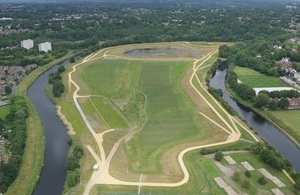Environment Agency publishes new evidence to plan for flood and coastal risk up to 2065
The study uses climate change, population and mapping data to set out future flood risk scenarios.

The £10 million Salford flood storage basin, opened in 2018, protects 2000 homes and businesses. The Environment Agency is investing £2.6 billion in flood and coastal erosion risk management projects between 2015 and 2021, helping to protect 300,000 homes.
The Environment Agency has published a new economic assessment to aid planning for flooding and coastal risk management over the next 50 years.
The study uses new climate change, population and mapping data to set out potential future scenarios, assessing how funding could be best allocated to meet these challenges.
The long-term investment scenarios report states that without sustained investment, future flood damage to properties and infrastructure in England will significantly increase. It estimates that an average annual investment of £1 billion will be necessary up to 2065.
The overall benefit to cost ratio of the new estimates is 9 to 1, which means for every £1 spent on protecting communities, around £9 in property damages and wider impacts would be avoided.
A full range of climate change scenarios demonstrate that a number of measures are needed to ensure that communities are resilient over the next half-century. These include building and maintaining large-scale engineered defences, natural flood management techniques such as planting trees and slowing the flow of water and property flood resilience for homes.
The findings will also provide new evidence for planning authorities and developers. As the population grows, the number of properties in the flood plain is set to almost double over the next 50 years. Current planning policy and implementation limits the impact on flood risk but continuing to make the right investment and planning decisions will be vital to keep pace with population growth and climate change.
Julie Foley, Director Flood Strategy at the Environment Agency said:
This report sets out the level of investment we need to consider over the next 50 years alongside the action we need to take to ensure that communities, businesses and vital infrastructure are resilient to flooding and coastal erosion.
The scenarios are a key evidence base to inform our Flood and Coastal Erosion Risk Management Strategy, due later this year, and will help government, businesses and the insurance industry plan for the future.
The report findings highlight the importance of continued investment to protect infrastructure including transport and utility networks, 41% of which are located in areas which are at risk of flooding.
The impacts of flooded infrastructure can be far more extensive than the immediate water damage, impacting on supply chains, travel and access to key services like hospitals and schools. The National Flood Resilience Review sets out how government is working with utilities companies, regulators and others to implement long-term resilience plans.
The Environment Agency is investing £2.6 billion in flood and coastal erosion risk management projects between 2015 and 2021, helping to protect 300,000 homes. Later this year, the EA will consult on its new Flood and Coastal Erosion Risk Management Strategy which sets out the long term vision for a nation more resilient to flooding and coastal change.
Read the Flood and coastal risk management: long-term investment scenarios